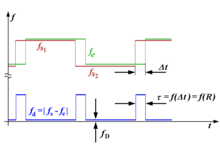Frequency-shift keying
This article needs additional citations for verification. (March 2009) |
| Passband modulation |
|---|
 |
| Analog modulation |
| Digital modulation |
| Hierarchical modulation |
| Spread spectrum |
| See also |


Frequency-shift keying (FSK) is a
Modulating and demodulating
Reference implementations of FSK modems exist and are documented in detail.[3] The demodulation of a binary FSK signal can be done using the Goertzel algorithm very efficiently, even on low-power microcontrollers.[4]
Variations
Multiple frequency-shift keying
Continuous-phase frequency-shift keying
In principle FSK can be implemented by using completely independent free-running oscillators, and switching between them at the beginning of each symbol period. In general, independent oscillators will not be at the same phase and therefore the same amplitude at the switch-over instant, causing sudden discontinuities in the transmitted signal.
In practice, many FSK transmitters use only a single oscillator, and the process of switching to a different frequency at the beginning of each symbol period preserves the phase. The elimination of discontinuities in the phase (and therefore elimination of sudden changes in amplitude) reduces sideband power, reducing interference with neighboring channels.
Gaussian frequency-shift keying
Rather than directly modulating the frequency with the digital data symbols, "instantaneously" changing the frequency at the beginning of each symbol period, Gaussian frequency-shift keying (GFSK) filters the data pulses with a
A GFSK modulator differs from a simple frequency-shift keying modulator in that before the baseband waveform (with levels −1 and +1) goes into the FSK modulator, it passed through a Gaussian filter to make the transitions smoother to limit spectral width. Gaussian filtering is a standard way to reduce spectral width; it is called pulse shaping in this application.
In ordinary non-filtered FSK, at a jump from −1 to +1 or +1 to −1, the modulated waveform changes rapidly, which introduces large out-of-band spectrum. If the pulse is changed going from −1 to +1 as −1, −0.98, −0.93, ..., +0.93, +0.98, +1, and this smoother pulse is used to determine the
Minimum-shift keying
Minimum frequency-shift keying or minimum-shift keying (MSK) is a particular spectrally efficient form of coherent FSK. In MSK, the difference between the higher and lower frequency is identical to half the bit rate. Consequently, the waveforms that represent a 0 and a 1 bit differ by exactly half a carrier period. The maximum
Gaussian minimum-shift keying
A variant of MSK called Gaussian minimum-shift keying (
Audio frequency-shift keying
Audio frequency-shift keying (AFSK) is a
AFSK differs from regular frequency-shift keying in performing the modulation at
) for transmission.AFSK is not always used for high-speed data communications, since it is far less efficient in both power and bandwidth than most other modulation modes.[
AFSK is used in the U.S.-based Emergency Alert System to notify stations of the type of emergency, locations affected, and the time of issue without actually hearing the text of the alert.
Multilevel frequency-shift keying
Phase 1 radios in the Project 25 system use 4-level frequency-shift keying (4FSK).[9][10]
Applications
In 1910, Reginald Fessenden invented a two-tone method of transmitting Morse code. Dots and dashes were replaced with different tones of equal length.[11] The intent was to minimize transmission time.
Some early Continuous Wave (CW) transmitters employed an
Most early telephone-line
AFSK is also used in the United States'
The
Caller ID and remote metering standards
Frequency-shift keying (FSK) is commonly used over telephone lines for
European Telecommunications Standards Institute
In some countries of
Telcordia Technologies
The
British Telecom
Cable Communications Association
The
See also
- Amplitude-shift keying (ASK)
- Continuous-phase frequency-shift keying(CPFSK)
- Dual-tone multi-frequency(DTMF), another encoding technique representing data by pairs of audio frequencies
- Frequency-change signaling
- Multiple frequency-shift keying (MFSK)
- Orthogonal frequency-division multiplexing (OFDM)
- Phase-shift keying (PSK)
- Federal Standard 1037C
- MIL-STD-188
- Spread frequency-shift keying(S-FSK)
References
- ISBN 978-0-07-112672-4., p 509
- ^ FSK: Signals and Demodulation (B. Watson) http://www.xn--sten-cpa.se/share/text/tektext/digital-modulation/FSK_signals_demod.pdf Archived 2012-09-07 at the Wayback Machine
- ^ Teaching DSP through the Practical Case Study of an FSK Modem (TI) http://www.ti.com/lit/an/spra347/spra347.pdf
- ^ FSK Modulation and Demodulation With the MSP430 Microcontroller (TI) http://www.ti.com/lit/an/slaa037/slaa037.pdf Archived 2012-04-06 at the Wayback Machine
- ^ ieeexplore.ieee.org, Sweeney, D.; "An introduction to bluetooth a standard for short range wireless networking" Proceedings. 15th Annual IEEE International ASIC/SOC Conference, Rochester, NY, US, 25-28 Sept. 2002, pp. 474–475. 2002.
- ^ Nordic Semiconductor. nRF24LU1+ Preliminary Product Specification v1.2Archived 2011-02-20 at the Wayback Machine
- ^ LPRF Archived 2017-01-04 at the Wayback Machine
- ^ Bhagwat, Pravin (10 May 2005). "Bluetooth: 1.Applications, Technology and Performance". p. 21. Retrieved 27 May 2015.
- ^ Essam Atalla et al. "A Practical Step Forward Toward Software-Defined Radio Transmitters". p. 1.
- ^ Steve Ford. "ARRL's VHF Digital Handbook". 2008. p. 6-2.
- ^ Morse 1925, p. 44; Morse cites British patent 2,617/11.
- ^ Bureau of Standards 1922, pp. 415–416
- ^ Little 1921, p. 125
- ^ Kennedy & Davis 1992, pp. 549–550
- ^ Peschke, Manfred; Pesche, Virgina (2016-12-24). "Kansas City Standard". swtpc.com. Archived from the original on 2016-12-24. Retrieved 2023-01-09.
- ISBN 9781440078590, Radio Communications Pamphlet No. 40. Revised to April 24, 1921.
- Little, D. G. (April 1921), "Continuous Wave Radio Communication", Electric Journal, 18: 124–129
- Morse, A. H. (1925), Radio: Beam and Broadcast, London: Ernest Benn Limited
External links
- dFSK: Distributed Frequency Shift Keying Modulation in Dense Sensor Networks
- M Nasseri, J Kim, M Alam - Proceedings of the 17th Communications & Networking, 2014, Unified metric calculation of sampling-based turbo-coded noncoherent MFSK for mobile channel
- J Kim, P Raorane, M Nasseri, M Alam - Proceedings of the 46th Annual Simulation Symposium, 2013, Performance analysis of sampling-based turbo coded NCQFSK for image data transmission

